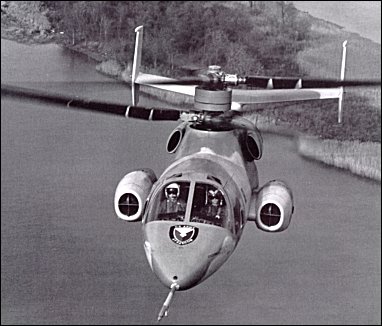|
|
In February 1972, Sikorsky announced the development of an experimental helicopter designated S-69, which was designed to study the Advancing Blade Concept (ABC). This new system consisted of two rigid, contra-rotating rotors which made use of the aerodynamic lift of the advancing blades. At high speeds, the retreating blades were offloaded, as most of the load was supported by the advancing blades of both rotors and the penalty due to stall of the retreating blade was thus eliminated. This system did not even require a wing to be fitted for high speeds and to improve manoeuvrability, and also eliminated the need for an anti-torque rotor at the tail.
The aim of the project was to evaluate the ABC with this helicopter, first using scale models for wind tunnel tests at the Ames NASA research center, and then the real aircraft, which flew on 26 July 1973. Unfortunately, however, this prototype was lost in an accident a month later. Following an enquiry, design modifications were requested, plus improvements to the control system. Tests were resumed in July 1975 with a second aircraft. When test flights as a pure helicopter were completed, a new experimental phase began with the addition of an auxiliary turbojet. In 1983 Sikorsky proposed further modifying the aircraft as the XH-59B, with a shortened fuselage and ducted fan providing forward thrust. G.Apostolo "The Illustrated Encyclopedia of Helicopters", 1984
In late 1971 the Army Air Mobility Research and Development Laboratory awarded Sikorsky a contract for the development of a single-engined research helicopter prototype designed specifically to flight test the company's Advancing Blade Concept (ABC) rotor system. The resultant Model S-69, which was allotted the military designation XH-59A and the serial number 71-1472, made its first flight in July 1973.
The XH-59A's ABC system consisted of two three-bladed, coaxial, contra-rotating rigid rotors, both of which were driven by the craft's single 1825shp PT6T-3 Turbo Twin Pac engine. During high-speed flight only the advancing blades of each rotor generated lift; this off-loaded the retreating blades and thereby eliminated the aerodynamic restrictions caused by blade-stall and the high mach number effect of the advancing blade tip. This, in turn, produced greater stability and manoeuvrability while eliminating the need for either a supplementary lift-generating wing or an anti-torque tail rotor. The XH-59A's streamlined fuselage more closely resembled that of a conventional airplane than a helicopter, having a cantilever tail unit with twin endplate rudders, side-by-side seating for the two crewmen, and fully retractable tricycle landing gear.
The crash of the first XH-59A early in the flight test programme led to the construction of a second prototype incorporating several significant control system modifications. This second machine (73-21941) flew for the first time in 1975, and in 1977 was converted into a compound rotorcraft through the installation of two 1350kg J60-P-3A turbojet engines. The modified machine was jointly evaluated by the Army, Navy, and NASA beginning in 1978, and was later able to reach and maintain speeds in excess of 515kph in level flight. The first prototype was ultimately rebuilt as a compound rotorcraft under a NASA contract and subsequently test flown (with the new serial 73-29142) by mixed Army, Navy, and NASA crews at NASA's Moffet Field, California, test facility. Both XH-59A aircraft were officially transferred to NASA following the 1981 end of joint Army/Navy participation in the tri-partite flight test programme. S.Harding "U.S.Army Aircraft since 1947", 1990
In 1972 Sikorsky designed the S-69 for the US Army, gaining a contract for two XH-59A prototypes to evaluate an Advancing Blade Concept (ABC) rotor system comprising two counter-rotating three-bladed rigid main rotors, with a 1361kW Pratt & Whitney Canada PT6T-3 Turbo Twin Pac to power them; the S-69 requires no tail rotor and has a conventional horizontal tail surface with endplate fins and rudders. Additional power is provided by two pod-mounted 1361kg thrust Pratt & Whitney J60-P-3A turbojets, one on each side of the fuselage, and the S-69 has demonstrated a speed of 488km/h. In 1982 these aircraft were developed into a new XH-59B configuration with advanced rotors, new powerplant, and a ducted pusher propeller at the tail. This approach was seen as a possible solution to the Army's search for a new light attack helicopter (LHX), and further funding was recommended. The S-69/XH-59 programme was abandoned, however, and the need for LHX was only answered in the 1990s with the selection of the RAH-66 Commanche. D.Donald "The Complete Encyclopedia of World Aircraft", 1997
* * *
 |
A Sikorsky XH-59A ABC in a landing configuration with gear lowered. The ABC concept is that the lift load of the aircraft at high forward speeds is carried primarily by the advancing rotor blades.
|
| Technical data for Sikorsky XH-59
Crew: 2,
engine: 1 x Pratt Whitney of Canada PT6T-3 Turbo Twin Pac turboshaft, rated at 1360kW and 2 x Pratt & Whitney J60-P-3A turbojets, 1350kg of thrust,
rotor diameter: 10.97m,
fuselage length: 12.42m,
height: 4.01m,
take-off weight: 4960kg,
max speed: 518km/h,
cruising speed: 185km/h,
ceiling: 4570m
|
Warning: mysqli_connect(): php_network_getaddresses: getaddrinfo for mysql5.zone.ee failed: Name or service not known in /data03/virt15346/domeenid/www.aviastar.org/htdocs/helicopters_eng/sik_s-69.php on line 103
Fatal error: Uncaught mysqli_sql_exception: php_network_getaddresses: getaddrinfo for mysql5.zone.ee failed: Name or service not known in /data03/virt15346/domeenid/www.aviastar.org/htdocs/helicopters_eng/sik_s-69.php:103
Stack trace:
#0 /data03/virt15346/domeenid/www.aviastar.org/htdocs/helicopters_eng/sik_s-69.php(103): mysqli_connect('mysql5.zone.ee', 'd14657sa18989', Object(SensitiveParameterValue))
#1 {main}
thrown in /data03/virt15346/domeenid/www.aviastar.org/htdocs/helicopters_eng/sik_s-69.php on line 103
|





